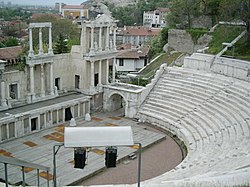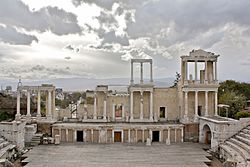This article needs additional citations for verification .(December 2019) |
 The foundations of the library | |
| Location | Plovdiv, Bulgaria |
|---|---|
| Coordinates | 42°08′36″N24°45′01″E / 42.143431°N 24.750206°E |
| Length | 15m |
| Width | 20m |
| History | |
| Material | bricks |
| Founded | 2nd century AD |
The library of Philippopolis is one of the administrative buildings built in the Northern part of the Roman forum in Plovdiv. The rectangular-shaped building has an approximate width of 20m and length of 15m. The library's main purpose was storing manuscripts and scrolls but it was also used as a place for education, reading, public discussions and speeches. Philippopolis was among the few ancient towns which had a library. [1]




